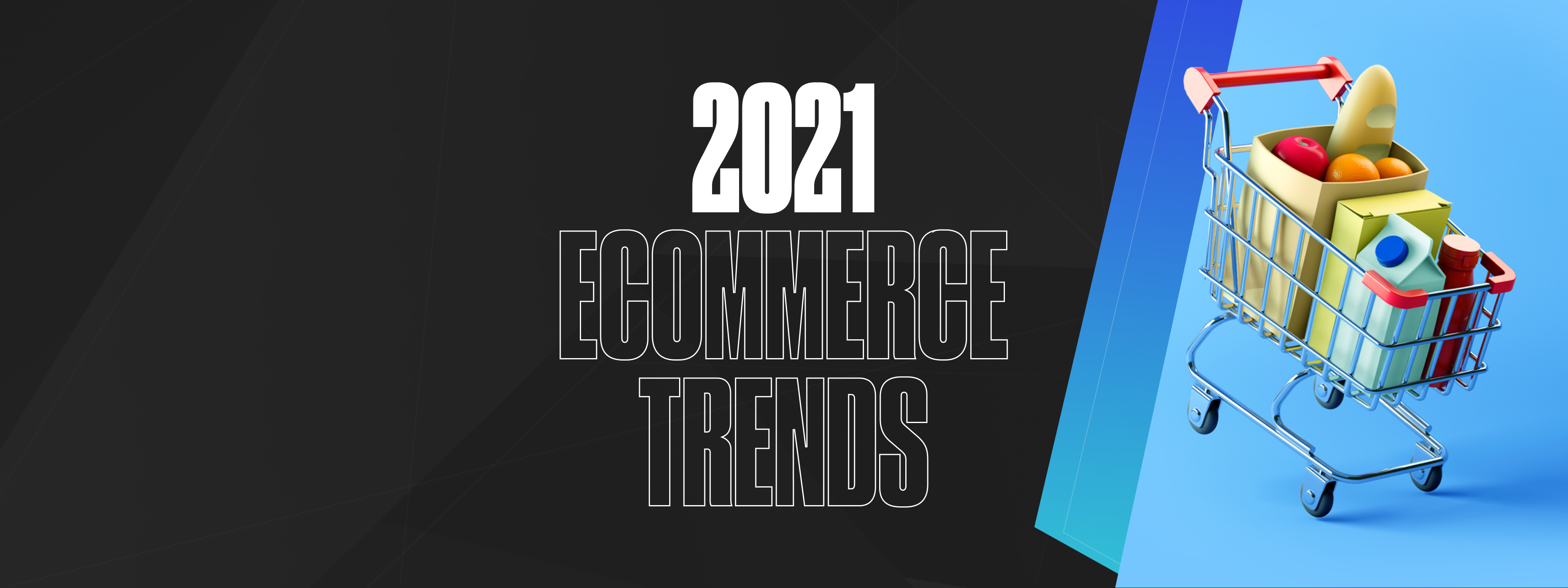The future of ecommerce: 7 trends to look out for in 2021
February 22

Digital trends usually happen slowly and organically, shaped by innovation and shifting behaviours. But the pandemic has accelerated things beyond belief, distilling years’ worth of trends into a period of just a few months.
Ecommerce is at an all-time high, acquisition costs are soaring, and fulfilment is becoming a competitive differentiator. Agility is more important than ever, putting automation and headless commerce at the centre of everyone’s attention. And consumer behaviours are continuing to move towards subscription models and sustainability, with brands having to adapt – or be left in the dust.
As we stretch our legs into the reality of the new year, here are seven key ecommerce trends to watch out for in 2021.
1. More customers – and more competition

Lockdowns and retail closures across the world saw ecommerce grow astronomically in 2020. 150 million new shoppers headed online during the peak of the pandemic, leading to 10 years worth of growth in the span of 90 days. And it wasn’t just the number of shoppers that changed – what those customers were buying changed, too. Without access to physical stores, product categories that were normally brick-and-mortar strongholds, such as household essentials and health and wellbeing items, found a brand new market online.
To keep up with the demand – and to offset the losses from store closures – retail giants had to level up their ecommerce efforts, with some wholesalers selling direct to consumers for the first time. But with so many extra options crowding the ecommerce market, the competition is fiercer than ever. And not every brand is ready for the challenge.
Whether it’s their infrastructure, fulfilment process or customer experience (or all three), businesses that are new to ecommerce are finding it difficult to compete with digital-first brands. According to Adobe, only 38% of the world’s largest companies are ready to compete online. While seasoned ecommerce brands could pivot their marketing strategies to work within the pandemic, some legacy brands were forced to rethink their entire business model – leaving them miles behind.
Top Tips
How can brands hope to compete in an uber-competitive market? The answer is fairly simple – invest in omnichannel. With 94% of all the lost point-of-sale transactions during the first month of the pandemic going to brands with a robust omnichannel strategy in place, cross-channel selling isn’t just effective – it’s essential. To keep up with established digital-first brands, you need to be reaching customers across channels, including your online store, marketplaces, retail, social media and wholesale.
But it’s not enough to sell on every channel. Anyone can do that. To overcome your competition, you need to create unified, immersive, personalised shopping experiences, wherever your customer is. And with over 70% of global ecommerce spend coming from mobile, a lot of that focus needs to be on your mobile experience. Beyond having a responsive website, consider developing a progressive web app or utilising accelerated mobile pages.
One key thing you can do to level up your omnichannel strategy is to build a robust technological ecosystem. By automating the transfer of data, unifying inventory levels and establishing a single source of truth, you can free your team up to spend more time optimising and refining your customer experience.
2. Retention is a top priority

Despite the fact that the impact of the pandemic saw overall ad spend fall by 20% in 2020, digital ad spend increased by 13%. As lockdowns left out-of-home advertising largely unseen, brands redirected their ad budgets online, with paid search up by 26% and social media by 25%. Brands that had usually invested in traditional advertising had to pivot to digital platforms, accelerating digital ad growth and driving up acquisition costs across channels.
And increased competition isn’t the only thing to blame for rising acquisition costs. With tech companies facing more scrutiny from lawmakers and regulators, digital advertising is heading into a period of uncertainty. The impact of these antitrust investigations is compounded by a lack of trust amongst consumers, a third of whom think digital advertising is too intrusive.
Another driver of this uncertainty comes from Google’s plan to phase out third-party cookies from Chrome by 2022. While the tech giant promises to develop alternatives to “sustain a healthy, ad-supported web”, it’s not yet clear what those alternatives will be – which means digital marketers need to prepare for a strategy without cookies. And with 62% of brands relying on cookies to target users, that’s a big undertaking.
Top tips
To combat these high acquisition costs, brands will need to prioritise customer retention in 2021. To do this, get to know your most valuable customers. Understand their customer journey, how and when they converted, which items they were interested in, and how long it took them to make a repeat purchase. By diving into the insights of your most loyal customers – and understanding what makes them come back – you’ll be able to find opportunities to recreate and accelerate that repeat-purchase journey across your customer base. It’s also worth segmenting these customers based on their lifetime value, and using historical purchase data to personalise marketing messages for your most valuable customers.
Another thing to consider in 2021 is rewarding the loyalty of those high-value customers. Shoppers that sign up to a loyalty programme are 47% more likely to make a second purchase, which, in turn, makes them more likely to become a long-term customer. So, if you haven’t already, now’s the time to launch a loyalty scheme.
To make your rewards scheme a success, establish a strategy. The best loyalty memberships – Amazon Prime, Nectar, the Boots Advantage Card – all act as a sort of mini brand, capturing customers’ imagination and giving the scheme a little more depth. You can also try adding urgency with limited-time discount codes or offering early VIP access to sales and product launches. If you opt for a points-based scheme, make sure those points are easily redeemable at the checkout to give customers a smooth, rewarding shopping experience.
3. Fulfilment is more important than ever

The fulfilment landscape has changed rapidly over the past decade, with Amazon Prime’s free one-day delivery offer working to shift consumer expectations across the world. And after the pandemic largely removed the option for in-person shopping, ecommerce brands have had to work even harder to meet customer demands.
The increased demand on ecommerce has also seen shipping companies raise their prices, with DPD, Hermes, FedEx and UPS all announcing increases in the wake of the pandemic. On top of this, brands have to contend with returns, which cost the industry over $1 trillion worldwide every year.
With higher rates and even higher expectations, brands are going to have to think about how they can turn their fulfilment strategies into a competitive advantage. Rather than hurting profit margins, businesses should plan to make their fulfilment process an integral, stand-out part of their customers’ shopping experience in 2021.
Top tips
Above all, brands should adjust to those high consumer expectations. As well as keeping shipping fast and free, a growing number of customers also expect orders to be delivered in sustainable packaging. And with the rise of unboxing videos, brands have the opportunity to go one step further and make the physical unboxing of a product an experience in itself – one that looks great on video. By using things like branded boxes, unique packaging, inserts and personalised touches, you can give your brand a little small-business charm and stand out from your competitors.
But no matter how good your packaging looks, it won’t make up for late shipping. To keep up in 2021, consider investing in a warehouse management system or 3PL if you haven’t already. By eliminating manual data entry, streamlining your inventory and reducing human error, investing in the right tech will help you improve your profit margins as you scale – giving you more time and resources to invest back into that fulfilment journey. You can find a list of first-class fulfilment companies over on our partner page.
4. Subscription models

Subscription-based ecommerce has been increasing rapidly over the past few years, and it’s a trend that’s set to continue in 2021. By 2023, it’s expected that 75% of direct-to-consumer businesses will offer subscriptions.
From food and drink to skincare and beauty boxes, the current market seems to offer a subscription for everyone – which makes launching a subscription incredibly competitive. But, if successful, they can be an incredibly useful business model. Not only do subscriptions offer a recurring revenue stream for brands, but they give customers a new, flexible way to engage with their favourite products.
Top tips
If you’re thinking of launching a subscription service in 2021, the first step is to decide what kind of service you’re looking to offer. There are three key types of ecommerce subscription models:
Once you’ve got a good list of subscribers, the challenge lies in retaining them. With curation subscriptions, this can be especially difficult; each box needs to create a consistent sense of value and variety. To do this, you’ll have to invest a lot of energy generating strong ideas, backed up by a good understanding of your target customers.
Another thing you can do to improve retention is to offer subscription tiers at different price points, giving customers a choice of how much they want to commit financially each month. By giving them the option to scale their subscription up or down, you’ll be able to retain customers who might have otherwise dropped off your subscriber list.
5. Marketing automation

The rise of software-as-a-service (SaaS) apps has led to another significant advancement in software: marketing automation. Over the past few years, dozens of new marketing apps have cropped up, with many centring themselves around automation. By 2025, the marketing automation software market is expected to be worth $16.87 billion, an increase of over $10 billion from 2019. And with competition in ecommerce narrower than ever, 2021 is set to see more brands move towards automated marketing strategies.
In an omnichannel world, marketing automation lets you run successful campaigns across your various customer touchpoints – whether that’s email, social media, SMS, push notifications, or your online store. While it’s by no means a quick-fix for stagnated growth, the right marketing software gives you the tools you need to nurture those hard-fought leads and turn them into happy customers.
Top tips
If you haven’t already invested in a marketing platform, 2021 might be a good time to do so. There are hundreds of apps to choose from, so have a look around, compare features and see which one works best for your brand.
There are dozens of different campaigns you can automate through a marketing platform. To establish a sustained level of growth, try building customer lifecycle campaigns, such as welcome, post-purchase and abandoned-cart series. Send automatic offers to customers who’ve not purchased in a while, offer personalised product recommendations, and retarget visitors in their social media feeds.
To get the most out of your marketing software, you’ll need to integrate it with your other key systems – such as your CRM, ecommerce store or ERP. Use your ERP or CRM as the single source of truth for all your customer data, and set up mapping rules to sync that data with your marketing app. With all this information ready to go in your marketing system, you’ll have everything you need to create personalised, targeted campaigns across your channels.
6. Going headless

As a buzzword, headless commerce has been bouncing around for a few years now – but the last year or so has seen a rapid increase in the number of stores favouring a headless approach. And with increased competition putting a new focus on customer experiences, 2021 likely to catapult headless commerce back into the spotlight.
Headless commerce architecture refers to the decoupling of the front-end layer of a website from the back-end ecommerce platform. This separation means developers can use the front-end tech of their choice (such as WordPress, Contentful or Prismic) and plug an ecommerce solution into the back-end to manage the commerce side of things. It also opens up more avenues for internationalisation, giving brands the power to sell in multiple languages and currencies – all from a single website.
Although headless is still a relatively new approach to ecommerce, dozens of major retailers have already moved over to a headless structure – including Amazon, eBay, Etsy, Netflix and Coca-Cola. Loved for its unrivalled flexibility, headless stores give developers the freedom to experiment and create freely, without being tied to the limitations of a traditional ecommerce platform.
This increased freedom for creativity also extends to marketing teams. With a headless structure, marketers can create and add content to the frontend system without disrupting your store’s ecommerce services. For brands looking to develop a content-heavy experience, going headless might be the perfect next step.
Top tips
Thanks to the unignorable rise in headless commerce, most major ecommerce platforms allow for headless builds – including Shopify Plus, Magento, BigCommerce and Salesforce Commerce Cloud. But that doesn’t mean all stores need to start going headless.
Aside from the implementation costs, headless commerce comes with its own set of cons that need addressing. Rather than managing one ecommerce platform, having a headless store means maintaining two different systems, which means two sets of fees and a higher development overhead. Often, it also means losing some of the functionality of your ecommerce platform, such as page-building and previewing content changes.
However, headless commerce might just be the perfect solution for brands looking to hyperfocus on their customer experiences in 2021. With unlimited room for experimentation on the front-end, headless commerce gives brands the freedom to build exceptional, lightning-fast storefronts in record time. They’re also easily replicable, which makes them perfect for launching new geographies, micro-brands and progressive web apps.
7. Sustainability as a tool for growth

Although climate change and sustainability has been on everyone’s radar for at least the last decade, the past couple of years have seen this knowledge sink deeper into public consciousness, actively shaping the way we shop. Where before convenience and price dominated the market, sustainability practices are increasingly impacting buying decisions, with 72% of shoppers across North America, Europe and Asia making a conscious effort to buy more environmentally friendly products.
With such a huge section of the market prioritising sustainability, environmental considerations are no longer simply a matter of ethics – businesses will need to adapt to keep up with their eco-friendly competitors. And with major discount brands frequently lagging behind in terms of sustainability, reshaping your brand as an eco-conscious choice is also a great way to win against those lower-priced competitors.
Top tips
It goes without saying that championing sustainability isn’t the easiest – or the cheapest – way to run a business. To make up for the financial impact incurred – and to keep up in an environmentally conscious market – brands will need to turn sustainability into a competitive advantage.
In 2021, make sure your brand has taken a clear stance on sustainability. For big businesses, set a deadline for minimising your impact on the environment – such as Amazon’s pledge to reduce their carbon emissions to zero by 2040. Make sure you look at every element of the supply chain, and aim to implement fair social and environmental practices across the board. For smaller brands, focus on your company’s everyday impact, such as packaging, sourcing environmentally friendly products, and paying a fair wage. Other things you can do to reduce your company’s environmental impact include sending digital receipts instead of paper slips and digitising your returns process.
Once you’ve established clear sustainability goals, use these as part of your marketing efforts. Beyond shouting about it on social media, make sure your sustainability stance is highlighted at every stage throughout the buyer journey – whether that’s on your homepage, on category or product pages, or linked to from your store’s navigational header. Make it easy for customers to find and digest your company’s green initiatives.
How Patchworks can help
Is your business ready for 2021? If not, it might be time to invest in an integration platform.
Whatever your brand’s goals are for the new year, Patchworks can help you go further than you ever thought possible. Streamline your fulfilment services, adopt world-leading tech and launch new markets. Automate the flow of data, improve your profit margins and redistribute valuable resources into other key areas of your business. With Patchworks acting as the foundational layer for your brand’s core systems, the possibilities are limitless.
Book a free demo today and find out what Patchworks can do for you.












